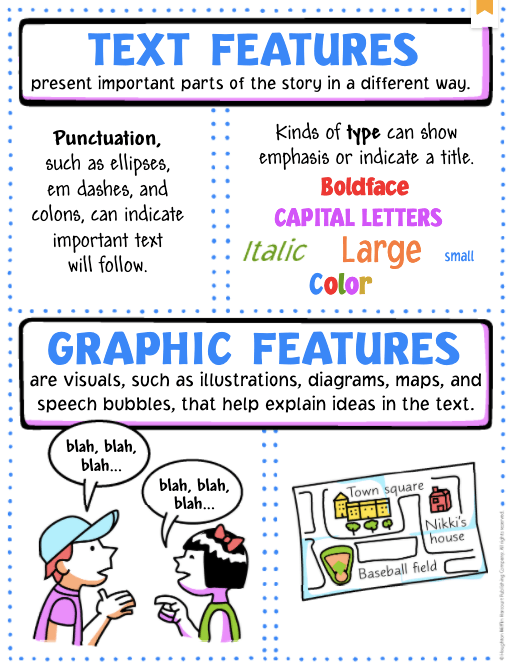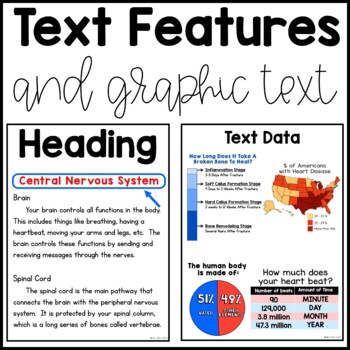
Text and graphic features are elements of a text that help readers understand and navigate the text more easily. They can be found in both print and digital texts, and can include things like headings, subheadings, bolding, italics, bullet points, tables, charts, and diagrams.
Text and graphic features are important because they can help readers:
- Locate information quickly and easily. For example, headings and subheadings can help readers get a quick overview of the main topics in a text, and bullet points can help readers scan for key information.
- Understand complex information. For example, diagrams and charts can help readers visualize complex concepts or relationships.
- Make connections between different parts of a text. For example, captions can help readers connect information in a photo or diagram to the main text.
- Increase their comprehension of a text. Studies have shown that readers who use text and graphic features are better able to understand and remember the information in a text.
Here are some specific examples of how text and graphic features can be used to improve the readability and comprehension of a text:
- Headings and subheadings can be used to organize a text into smaller sections and to indicate the main topic of each section. This can help readers to quickly scan a text to find the information they are looking for, and to understand the overall structure of the text.
- Bolding and italics can be used to emphasize important information in a text. For example, bolding can be used to highlight key terms or concepts, and italics can be used to highlight examples or quotations.
- Bullet points can be used to list items in a clear and concise way. This can be helpful for listing steps in a procedure, or for summarizing the main points of a section.
- Tables and charts can be used to organize and present data in a visually appealing and easy-to-understand way. For example, a table could be used to compare and contrast different products, or a chart could be used to show the trend of data over time.
- Diagrams and images can be used to illustrate complex concepts or relationships. For example, a diagram could be used to show how the parts of a machine work together, or an image could be used to show a real-world example of a concept.
Text and graphic features are an essential part of many different types of texts, including textbooks, articles, manuals, and websites. Authors and publishers use text and graphic features to make their texts more readable and understandable for their readers.
Here are some tips for using text and graphic features effectively:
- Use headings and subheadings to organize your text and indicate the main topics of each section.
- Use bolding and italics to emphasize important information.
- Use bullet points to list items in a clear and concise way.
- Use tables and charts to organize and present data in a visually appealing and easy-to-understand way.
- Use diagrams and images to illustrate complex concepts or relationships.
- Make sure that all text and graphic features are clearly labeled and easy to understand.
By following these tips, you can use text and graphic features to make your writing more readable and understandable for your readers.
Examples of Text and Graphic Features in Different Types of Texts
Here are some examples of how text and graphic features are used in different types of texts:
- Textbooks: Textbooks often use text and graphic features to help students understand complex concepts. For example, a textbook on biology might use diagrams to illustrate the structure of cells or the different parts of the human body.
- Articles: Articles often use text and graphic features to make their information more visually appealing and easy to understand. For example, a news article might use a chart to show the results of a recent poll, or a magazine article might use a photo to illustrate a key point.
- Manuals: Manuals often use text and graphic features to provide clear and concise instructions. For example, a car manual might use diagrams to show how to change a tire, or a computer manual might use bullet points to list the steps involved in setting up a new printer.
- Websites: Websites often use text and graphic features to make their information more visually appealing and easy to navigate. For example, a website for a company might use headings and subheadings to organize the information on its homepage, or it might use images and videos to showcase its products or services.
How to Teach Students About Text and Graphic Features
Text and graphic features are an important part of literacy instruction. Teachers can help students to learn about text and graphic features by:
- Teaching students the names and purposes of different text and graphic features.
- Modeling how to use text and graphic features to find information, understand complex concepts, and make connections between different parts of a text.
- **Providing students with opportunities to use text and
WebUnT10. analyses how text features are used to support or conflate the point of view in the text (e.g. the strategic use of images such as a cartoon in an editorial) (C) applies and. WebLet's talk about text features! Text features include resources like charts, maps, images, timelines, and other parts of a passage that aren't just the words! They. WebGlossary Support for ELA.2.10.C. print and graphic features. Print and graphic features are parts of a text that draw the reader's attention to important information. Print features are.
Text and Graphic Features 1/21/20 | English – Quizizz

Source: quizizz.com
Text Features and Graphics by Hillary Kiser – Hillary's Teaching Adventures

Source: teacherspayteachers.com
Text and Graphic Features – Grade 4 – YouTube

Source: youtube.com
What Is The Purpose Of Text And Graphic Features, Text and Graphic Features with Diagrams, 1.49 MB, 01:05, 15,020, Carrie Zaragoza, 2020-05-29T14:31:53.000000Z, 2, Text and Graphic Features 1/21/20 | English – Quizizz, quizizz.com, 669 x 507, jpg, , 3, what-is-the-purpose-of-text-and-graphic-features
What Is The Purpose Of Text And Graphic Features. WebText features are parts of a text that aren’t in the main story or body of text. They’re most common in nonfiction texts and help readers find information quickly and get more out of the text they’re reading. WebWhat is the Purpose of Text Features? Each text feature has a specific purpose in nonfiction material, while the overarching goal of every text feature is to.
Instructional video on how to use text and graphic features with diagrams to better understand a text.– Created using Powtoon — Free sign up at powtoon.com/youtube/ — Create animated videos and animated presentations for free. PowToon is a free tool that allows you to develop cool animated clips and animated presentations for your website, office meeting, sales pitch, nonprofit fundraiser, product launch, video resume, or anything else you could use an animated explainer video. PowToon’s animation templates help you create animated presentations and animated explainer videos from scratch. Anyone can produce awesome animations quickly with PowToon, without the cost or hassle other professional animation services require.
Text and Graphic Features 1/21/20 | English – Quizizz
What Is The Purpose Of Text And Graphic Features, WebGlossary Support for ELA.2.10.C. print and graphic features. Print and graphic features are parts of a text that draw the reader's attention to important information. Print features are.
Text and Graphic Features with Diagrams

Source: Youtube.com
Nonfiction Text Features | Jack Hartmann

Source: Youtube.com
The Falcon Find – Step 3: Text and Graphic Features
meaning that you see them, and they look very different than the rest of the words on the page or in the book.. Click on the links below to learn more about them and to continue your quest! .
Text and Graphic Features
Enjoy the videos and music you love, upload original content, and share it all with friends, family, and the world on YouTube. .
Text and graphic features
3. Textbooks and informational text also have important elements that stand out from the other parts of the text. , 5. These are called Text Features and their purpose is help us understand the information presented. .
.
Guiding Students Through Expository Text with Text …
Text organization refers to the patterns and structures used by the author(s) to write the text. A well-organized text assists the reader through predictable placement of information. A poorly organized text can impede the reader by being counterintuitive. The content of a text is what we want students to learn. .
.
.
What Are Text Features? The 6 Most Common Text Features – A Tutor
The most common areas for nonfiction text features are the index, table of contents, captions under pictures or diagrams, glossary terms, labels or features of graphs and charts, and bolded words. Each text feature has its purpose, but the overall goal of all text features is to quickly gain access to information in nonfictional material. .
Emphasize the 3 purposes of text features
When the information stated in words, sentences, and paragraphs is dense or complex, a graphic representation can make it clearer. 3. Add NEW INFORMATION. Authors are experts on the topics they write about. And sometimes everything doesn’t fit or flow logically within the single main text. Consequently, authors may choose to provide additional information outside of the main text. Reading these text features extends the reader’s knowledge even further. It’s not always clear to the reader what information in a text feature was new versus repeated until after he finishes reading. .
What is Graphic Design? — updated 2023 | IxDF What is Graphic Design? Graphic design is a craft where professionals create visual content to communicate messages. By applying visual hierarchy and page layout techniques, designers, .
.
.
ELA.2.10.C – TEKS Guide
Print features are the use of words to explain something in the text (e.g., titles, bold and italicized font, headings, subheadings, captions, glossary, index, table of contents). Graphic features are pictures, visual aids, or other images within a text used to support the author’s purpose and , .
What are Text Features? – TeachHUB
Text features are used to help navigate and locate specific information provided in a nonfiction text in an easier and more efficient manner. Often times, authors put information in the text features that are not included in the body of the text, so it is imperative to understand how to use them effectively. Each text feature has a specific purpose in nonfiction material, while the overarching goal of every text feature is to quickly and easily gain access to information. .
Using Text Features
The community of John A. Ferguson Senior High School is engaged in an educational journey with high standards for social, academic and physical instruction. All students will emerge with integrity and become lifelong learners so that they can succeed in a competitive, ever-changing global economy. .
Text Features and Their Purposes | Lesson Plan | Education.com
This lesson helps your ELs identify nonfiction text features and explain how they enhance comprehension of the text. .
Teaching Text Features to Support Comprehension
Capstone Classroom provides a huge selection of nonfiction paperback books to meet every school’s curriculum needs, from PreK through Secondary! .
TEXT FEATURES
The Department of Public Instruction is the state agency that advances public education and libraries in Wisconsin. Our mission is to advance equitable, transformative, and sustainable educational experiences that develop learners, schools, libraries, and communities in Wisconsin. .
Non-Fiction Text Features and Text Structure
Text features also help readers determine what is important to the text and to them. Without a table of contents or an index, readers can spend wasted time flipping through the book to find the information they need. Special print helps draw the attention of the reader to important or key words and phrases. .
Post a Comment